|
CHAPTER FOURTEEN
Should we continue to dismiss the Sumerian and Biblical accounts as mythology? In the previous three chapters, I have put forward a scientific basis for dating the rebellion of the Gods, after 40 periods of toil, to 183,783 BC. As a result, man was genetically created as a slave 3,600 years later. But what exactly was the “toil” of the Gods, to which I have repeatedly referred in earlier chapters? What evidence can demonstrate the nature of the toil and the purpose of the Gods on Earth?
Inevitably we will achieve little by searching in vain for evidence hundreds of thousands of years old. Instead we must focus on the last 13,000 years since the Flood, and examine the relationship between the Gods and mankind. Only then can we assess the reasons why the Gods first came to Earth. Our search begins with the legendary figure of Nimrod. The Biblical Table of Nations states that Noah’s son Ham fathered Gush and that:
This passage has always puzzled Biblical scholars. It is widely acknowledged that the line of Ham (meaning “He who is Hot”) represents the darker-skinned Negroid race, but the lands of Mesopotamia were dominated by the Shemitic people. Scholars have therefore interpreted the Biblical text as an invasion by Nimrod of the Shemitic lands. Unfortunately, despite numerous archaeological excavations, no evidence whatsoever has come to light to identify Nimrod or a Negroid kingdom in any of the cities named by Genesis.
As one authority comments:
The second slightly puzzling point is the Biblical description of Nimrod as a “hunter before the Lord”. However, as explained by the McClintock and Strong Cyclopaedia, the term “hunter” should not be taken literally:
Nimrod was therefore “a mighty campaigner before the Lord”, but still the meaning of the statement does not shine through. In order to decipher Nimrod’s role, we must examine the sense of the Hebrew word liph-neh which is commonly translated as “before”. In fact, its use elsewhere in the Bible signifies a meaning of opposition.
Suddenly, the significance of Nimrod’s first venture, at Babylon, becomes clear. If we translate “Lord ” as Enlil (rather than the Bible’s retrospective use of Yahweh), then Nimrod becomes the perpetrator of the Tower of Babel, in opposition to Enlil. In chapter 10, however, we noted that the Tower of Babel incident was an act of defiance by Marduk - an attempt to rebuild his pre-Flood city in Babylon.
Who then was the guilty party, Nimrod or Marduk?
As one commentator has pointed out, Marduk and Nimrod were both cited by ancient myths for their acts of rebellion. Some authorities have therefore mistakenly come to the conclusion that the rebel Nimrod and the rebel God Marduk were one and the same person. Unfortunately, such a theory is immediately sunk by the second and third cities named by Genesis, for Erech and Akkad were the cities of Marduks arch enemy, Inanna.
How can we resolve this strange contradiction? The most likely explanation is that Nimrod was not a warrior-king, but a slave. His campaign began at Babylon, in support of Marduk, and ended with an assignment to Inanna (Marduk’s arch-rival) in punishment for his rebellion. Only this conclusion can explain the archaeological invisibility of Nimrod’s presence in Mesopotamia, an invisibility which is entirely characteristic of an enslaved people. Why would slavery have been practiced by the Gods six thousand years ago? If we review the timing of events, the answer becomes clear.
For seven thousand years after the Flood, the fertile crescent of Mesopotamia had been waterlogged. Eventually, the situation improved and the Gods decided to rebuild their cities on the sites of the pre-Flood flight path. The first city to be rebuilt, we know, was Eridu c. 3800 BC.
The second was probably Nippur. But despite this sudden urge for new cities, no-one seems to have asked who physically built them. The technology may have come from the Gods, but who provided the muscle power? The list of cities built by Nimrod encompasses Babylon in 3450 BC, Agade in 2400 BC and Nineveh probably around 2300 BC.
These dates span a period of over a thousand years, once again corroborating the human longevity that existed during this era. It is thus possible that the legends of Nimrod rebuilding Baalbek immediately after the Flood may have some historical basis.
Our study of Nimrod is about to take
us to some very strange places indeed.
These ancient peoples possessed complex calendars and astronomical knowledge, they built pyramids similar to those in Egypt and Mesopotamia, and they spoke of their ancestors arriving by sea. And yet archaeologists continually ignore all these clues and study Mesoamerican civilization as an entirely separate subject, searching in vain for a home-grown story line. There is no greater embarrassment to these archaeologists than the earliest of all the Mesoamerican people - the Olmecs. The Olmecs mainly inhabited the Gulf Coast of Mexico.
Today, their cities are found in swampy lowland areas, making travel and excavation particularly difficult. As a result, we know frustratingly little about these people. However, what we do know comes as a total bombshell, for their main legacy to us is a collection of huge stone heads, with Negroid features!
Sixteen of these unusual Negroid heads have so far been found at the sites of San Lorenzo, Tres Zapotes and La Venta. Many of these heads have been moved to museums, including the splendid open-air jungle museum at La Venta Park. Plate 56 shows a typical head from La Venta Park, with flattened face, thick lips, broad nose, almond-shaped eyes - indisputable Negroid characteristics.
This particular head is 7-feet high and weighs an incredible 24 tons! The rest of the heads range from 5-10 feet in height, with the largest weighing around 30 tons. As astounding as it is to find African features in Mesoamerica, it is equally astounding how these huge basalt stones could have been transported over distances of 40-80 miles from the nearest quarries. In addition to the carved heads, the Olmec sites contain numerous unfinished stone balls, indicating that their work was abandoned in mid-course.
But why did they ever begin such a huge project? Why expend so many man-hours on a seemingly pointless exercise? Needless to say, the discovery of African features on these Olmec heads has the archaeologists completely stumped. Their embarrassment has only grown as a result of radiocarbon dating tests at San Lorenzo which have dated the site at which the heads were found to at least 1200 BC.
National Geographic is now openly conceding a date of 1400 BC for the Olmec site of Teopantecuanitlan, whilst other authorities are suggesting 1500 BC as the most likely date of their emergence. The culture of the Olmecs is revolutionary, having no precedent whatsoever in Mesoamerica. Whilst they are most famous for their legacy of the giant Negroid heads, there are other features of Olmec society which are equally intriguing.
As one expert points out:
This sudden, advanced culture inevitably reminds us of the Sumerians. Professor Walter Krickeberg has suggested that the Olmec culture is like a legacy. which must have had an “external impulse. Almost without exception, however, the academic community looks the other way. Are they uncomfortable with the concept that a Negroid people could have been the source of the earliest Mexican cultures? This racial aspect is certainly de-emphasized by many of the books on ancient civilizations, who prefer to blandly label the Olmecs as a “race of precursors”.
Other books, meanwhile, ignore these anomalous people altogether or craftily focus attention on the Zapotecs, a later culture which may have been geographically connected to the Olmecs. If we study the Olmec culture without any prejudice or preconceptions, what can we conclude? First, several clues are provided by surviving Olmec works of art. For example, a carved block of basalt found at La Venta (Plate 57) depicts a crouching figure emerging from what appears to be an underground cave.
The man holds in his right hand a rope which is connected to the wrist of a colleague carved on the side panel. This stone is conventionally interpreted as an “altar”, but if we use our eyes, rather than our preconceptions, what we see is either a prisoner or a miner. If we now return to the giant Olmec heads, we notice that, without exception, they are fitted with protective helmets with side-straps.
This is a significant clue, not to be dismissed as decorative headgear or fancifully linked to astronauts, but highly indicative of a mining helmet, indeed, another Olmec carving at La Venta, supports this conclusion. Figure 40 shows a 9-feet high stone slab known as the King’s Stele.
The main feature is a man with
Negroid features, grasping a tool shaped like a hockey stick. The
religious interpretation of this tool is a crook (to go with the
“altar”!), but it seems to me to be some kind of tool. Furthermore,
above the central figure are two smaller figures, one on each side,
again wielding tools - a pole and an axe respectively.
The purpose of these trenches is unknown. Meanwhile, at the site of San Lorenzo, archaeologists have been completely mystified by a network of artificial reservoirs which are connected by subterranean conduits and sluices. These elaborate earthworks and stone constructions are probably typical of the forty or so known Olmec settlements, many of which have never been properly excavated. It all smacks of a purposeful, functional design.
The answers can be deduced from the mysterious sites of South America, but first I would like to take a small detour northwards to the famous site of Teotihuacan.
Back
to Mensajes de Civilizaciones Andinas y Americanas
These legends are reflected in Teotihuacan’s two principal monuments, the Pyramids of the Sun and the Moon, which dominate the landscape with heights of 212 feet and 140 feet respectively. Most books tell us that Teotihuacan dates from 200 BC, but in fact it already occupied 4.5 square miles by that date; therefore the city’s origin must have been much earlier.
This vast metropolis is thought to have been a magnet for surrounding cultures, but despite identifying the presence of many diverse peoples, the archaeologists are still not at all clear who the original Teotihuacanos were. Unfortunately, they are concentrating their search around the date 200 BC.
Could the Maya have built Teotihuacan?
Despite the Maya having an advanced civilization by 200 BC, they were based a long way to the south, in Yucatan, Guatemala and Honduras. There were clear cultural links between the Maya and Teotihuacan, but these date to later times. No-one is seriously claiming a Mayan origin for this city. Who else in Mesoamerica might have built Teotihuacan? Could it have been the Zapotecs, a mysterious people identified with the city of Monte Alban, where they emerged into the history books c. 500 BC?
A National Geographic update on Teotihuacan acknowledges the presence of the Zapotecs, but describes them as latecomers, strangers who settled near the city limits, possibly for trading purposes. Could it have been a city of the Toltecs? This mysterious people are associated with the city of Tula (also known as Tollan), which is close to Teotihuacan geographically, but is dated to a much later period, c. AD 500-700. Nevertheless, a culture does not appear overnight, and it is a fair bet that the Toltec culture was originally established at Teotihuacan.
However, that does not mean that the Toltecs built it. So far, only small sections of Teotihuacan’s eight square miles of temples, palaces and residences have been excavated. Further clues to its origins may still lie buried in the ground. In the absence of any form of writing at Teotihuacan, the archaeologists are shooting in the dark.
Karl Taube, an archaeologist from the University of California sums up our current state of knowledge:
What we do know about Teotihuacan only adds to the mystery. The site appears to have been laid out with amazing technology. The Street of the Dead, the main axis of the site, runs perfectly straight for 2 miles, and archaeological evidence suggests that some form of sophisticated direction-determining device was actually used in its construction.
Furthermore, the layout of the site was based on a 15.5 degree tilt from the cardinal points, a tilt which some experts believe was a deliberate alignment with the Pleiades star constellation. One study of Teotihuacan has even suggested that the entire site was laid out mathematically to represent the orbits of planets in the Solar System.
Archaeologists have found the whole site of Teotihuacan - pyramids, streets and floors of houses - to be inexplicably paved with water-resistant stucco. Excavations in the Atetelco part of the city reveal apartments with sunken courtyards or patios open to the sky, apparently designed to capture rainfall.
National Geographic reports:
At the Pyramid of the Sun, archaeologists have discovered a sunken space or channel surrounding it on three sides. Underneath the pyramid, a mysterious underground cave has been found, along with a complicated network of subterranean chambers, passages and drainage pipes. Some of these chambers contain a thick layer of mica.
This mica has natural insulating properties, which make it resistant to water, heat and electricity. Experts have traced the source of the Teotihuacan mica 2,000 miles away in Brazil! Meanwhile, the rerouting of the San Juan river away from its normal course and towards the city provides another vital clue. Could water have played a vital role at Teotihuacan?
It has been suggested that an underground water source once existed, close to the Pyramid of the Moon (Plate 59). That pyramid, like the Pyramid of the Sun, is surrounded by a mysterious sunken channel and once featured a prominent statue of a “water Goddess”. It is possible that water from the Pyramid of the Moon flowed down the Street of the Dead and was ultimately carried away by the San Juan river?.
These flowing waters, together with the subterranean drains and sluices, bring to mind the sites of Tiwanaku and Chavin de Huantar, which we studied in chapter 3. It may be no coincidence that Tiwanaku also has natural springs which still produce to the south of the site, as a result of a high groundwater level in that region. We can only surmise that all of these sites used the flowing waters to support an unidentified industrial process (or processes). Unfortunately, no experts have ever studied Teotihuacan from such a controversial perspective!
Little mention is made, for instance, of the 900 BC radiocarbon dating at Teotihuacan, established by Miguel Covarrubias in the 1950s, nor the more recently confirmed radiocarbon dating of 1474 BC. Open-minded archaeologists are now joining the growing consensus that much of Teotihuacan was built as early as 1400 BC. Amazingly, Aztec legends can corroborate a date of 1400 BC for the beginning of Teotihuacan in its present layout.
The Aztec legends tell of a day when the Earth fell into total darkness except for Teotihuacan, where a sacred flame continued to burn. The Gods then gathered together at Teotihuacan and attempted to move the Sun and the Moon, which were stationary. According to various versions of the legend, an arrow was fired or the wind God blew into the sky. In any event, the Sun and the Moon continued their course and the world was saved.
From this legend, the Aztecs drew their notion that time had stopped and then begun again, and the pyramids of Teotihuacan were thereafter associated with the Sun and the Moon. These Aztec legends strongly suggest that the pyramids of the Sun and Moon were built to commemorate the day when the Sun failed to rise. Was this a real event and, if so, when did it occur?
Fortunately, Zecharia Sitchin has established for us a chronology which links the day when the Sun failed to rise in the Americas with a day when the Sun stood still on the opposite side of the world! The event in the Americas is recorded by the chronicles of Montesinos, which describe a day when the Sun failed to rise in the Andes. This unusual event occurred in the third year of the reign of the pre-Incan monarch Titu Yupanqui Pachacuti II, when “there was no dawn for twenty hours”. Sitchin has dated this observation to precisely 1391 BC.
Meanwhile, on the opposite side of the world, in the east, the same event is recorded in the Biblical Book of Joshua:
Based on an Exodus date of 1433 BC (see Appendix A), Sitchin has dated the Israelite entry into Canaan 40 years later in 1393 BC, and the day the Sun stood still would thus have occurred shortly afterwards, exactly in agreement with the Andean chronology! The consistent details of the out the possibility of an eclipse.
Instead, the most spin was temporarily affected by the close passing comets have counter-clockwise orbits, and would direction of rotation. This suggestion is refers to “large hailstones” coming down from broken off and entered the Earth’s atmosphere. myths, thus appears to have a solid scientific Teotihuacan already existed in 1391 BC, allowing to commemorate the “rescue” of the Sun and by the earliest radiocarbon datings of the site to earlier cultures to identify the builders of cultures in Mesoamerica to choose from.
The duration of the event (“twenty hours”) rule likely scientific possibility is that the Earth’s of a large comet. It is an established fact that hence act as a force against the Earth’s supported by the Book of Joshua 10:11 which sky - fragments of the comet which had The Aztec creation legend, like most other basis. Furthermore, the legend indicates that for the possibility that it was then enlarged the Moon.
Such a conclusion is supported c. 1400 BC. We must therefore look to much Teotihuacan. At 1400 BC there were few Maya are recognized to have emerged around 1200 BC and they were based too far south.
The style of the pyramids at Teotihuacan is also quite different from anything which the Maya ever produced. We are thus left with only one apparent solution - the mysterious Olmecs who emerged in Mesoamerica around 1500 BC. I shall now return to the question I posed earlier.
Why would the Olmecs go to such enormous lengths to move 30-ton basalt balls over distances up to 80 miles, and then carve them with such disapproving, indeed suggestion, based on the slaves. Within a hundred Gulf Coast homeland, the Gods to leave their cities and Olmecs therefore set about fierce-looking stone heads purpose was to mark their potential settlers during their carved with unique features, frightening, faces?
Here is my theory that the Olmecs were years of settling in to their Olmecs were ordered by the build Teotihuacan. The an urgent project to erect around their cities. The territory and frighten off any absence. Each head was thus and with a size that played up to their image as men of “giant” stature.
In misconstruction, time ran out and the Olmecs were forced to head northwards on their new quest. Other than the evidence to place the Olmecs at on Nimrod as a slave, the comments of Linda Autonomous University of Mexico, are fascinated to find that most of the site at one-storey stone apartment compounds.
Struck by the scale and uniqueness of these compounds, Manzanilla hinted at the notion of a massive enslaved work force:
Manzanilla has also studied a labyrinth of caves surrounding the site, which she believes are the result of the mining of the volcanic rock which was used to build the pyramids. Who were the people of this huge labour force, who mined, moved and constructed 35 million cubic feet of rock for the Pyramid of the Sun alone?
Who else in Mesoamerica but the Olmecs fit this profile? We should recall that the grid-pattern of Teotihuacan was carefully pre-planned from the very beginning. We should recall the many inexplicable features of that city, which bring to mind Olmec sites such as La Venta, which had similar subterranean tunnels and waterworks systems.
We should also note the widespread examples of Olmec art found at Teotihuacan. And finally, we should take note of the Teotihuacan chronology c. 1400 BC, and the presence of the Olmecs in Mesoamerica at that time, commemorated by one of the central themes of Olmec art - Negroid figures, in clay or stone, peering upwards to the sky. The symbolism of this has baffled the experts, but to me the meaning is quite clear.
The anxious skyward gaze marks the day in 1391 BC when the Sun did not rise, a day so unique in human experience that the Bible states “there has never been a day like it before or since”. Once again, the evidence confirms the presence of the Olmecs in America c. 1400 BC.
Where were the Olmecs before they arrived in Mesoamerica? In chapter 3, we marvelled at the incredible megalithic stonework of Tiwanaku in Bolivia, which, based on the alignment of the Kalasasaya temple, has been dated to at least 4050 BC. We were also intrigued by the findings of subterranean enclosures, particularly the over- engineered water conduits inside the Akapana.
We found at Tiwanaku a site built for an obscure functional purpose, devoid of any writing that might provide a clue to its history. It is a picture that bears many similarities to Teotihuacan in Mexico. In fact, one team of scientists has found incredible similarities between the Akapana in Tiwanaku and the Pyramid of the Moon in Teotihuacan. Whilst the purpose of Teotihuacan remains a mystery, there are many clues to suggest that the product of Tiwanaku was bronze, an extremely hard and useful alloy comprising 85 per cent copper and 15 per cent tin.
Evidence of copper at Tiwanaku is evident even to the casual observer. On my visit to the site, I found that patches of a greenish-white coppery residue had appeared at the side of the pond inside the Akapana. A similar greenish-white residue had also appeared in a long stripe on the ground inside the Kalasasaya. In addition, the entire site is covered with mysterious green pebbles, possibly discoloured by exposure to copper. The purpose of this gravel is a mystery to the archaeologists.
Alan Kolata believes that it has a natural origin, being washed down from a nearby mountain, although he admits it is a mystery why the Tiwanakans went to so much trouble to bring billions of these tiny pebbles to the site. As usual, the gravel is dismissed as a weird religious cult. My own impression, in contrast, was that this green gravel is the legacy of a very ancient phase of Tiwanaku, perhaps from before the Flood; only flooding would account for the widespread occurrence of the pebbles over such a large area and to some considerable depth in the soil. If copper was indeed used at Tiwanaku, it did not have to come far, for the Andes mountains contain rich copper deposits.
However, the more important component of bronze is tin, a metal obtained by a difficult extraction process from cassiterite ore. Whilst copper deposits are quite commonplace, cassiterite ore is relatively rare. It is thus highly significant that Tiwanaku is situated directly on top of one of the world’s largest belts of cassiterite.
Similarly, the Sumerian word for copper was URU, a significant clue perhaps to the role of the mysterious Uru tribe of Lake Titicaca. As Alan Kolata has pointed out, the Uru Indians were at one time proliferous along the rivers connecting Titicaca to Lake Poopo and the nearby town of Oruru. Perhaps their origin is connected with the transportation of copper, as the name which has been given to them suggests. Assuming that Tiwanakan bronze production commenced c. 4050 BC, the obvious question to ask is why it was not started thousands of years previously, when the space facilities of the Gods were being constructed.
If Tiwanaku was not functioning, then the bronze for those constructions must have come from elsewhere. What happened to that earlier source of bronze, and why did production then shift to Tiwanaku? Did that earlier source become exhausted or did it, for some reason, become unworkable? An intriguing possibility is that the earlier centre of metallurgy was in Antarctica, where there are extensive mountain ranges, rich in mineral deposits.
Sedimentary core samples, taken from the Ross Sea by the 1949 Byrd Expedition, have proved that rivers flowed freely in Antarctic prior to 4000 BC, when it then became glaciated. Any mining activity in Antarctica would have had to cease in 4000 BC. It may be no coincidence that this date precisely matches the beginning of Tiwanaku. Were there Negroid miners present at Tiwanaku? Could this be the place where the Olmecs learned mining and perhaps mineral processing techniques? The bridge to make this connection is a mysterious people from Mesopotamia, known as the Kassites.
The Kassites are most famous for their occupation of Babylon in the sixteenth century BC, after that city fell to the Hittites. Prior to that, the Kassites had lived in the Zagros Mountains, to the north-east. Curiously, just like Nimrod and his followers, the Kassites were virtually an invisible people. Even when they occupied Babylon, they made no cultural changes whatsoever.
Their contemporaries regarded them as a barbarous people, but in ancient times the word “barbarian” had no negative connotations. The origin of the term is actually the Greek word barbaros, which was used to describe a “non-Greek foreigner” someone who could not be understood due to their babble or unintelligible language.
The Greek word barbaros is, in turn, ultimately derived from the Sumerian word BAR, meaning “metal”. The repeated syllables in BAR.BAR may thus have originally signified a foreigner who was associated with various metals. The Kassites were therefore not barbarians in the modern sense, but foreigners who worked with metals.
One scholar has indeed suggested that the name Kassite derives from a common origin with the term cassiterite (tin ore), and has linked the appearance of the Kassites c. 2200 BC with a dramatic increase in the previously dwindling tin content of bronze products in Mesopotamia.
Other
scholars have compared the term Kassite to Cushite, noting that the
Akkadian name for the Kassites was Kashshu. Geographically, the
Kassites were associated with the region of ancient Elam known as
Kushan. It was in this region of the Zagros Mountains that
cassiterite was mined in ancient times, passing from the Zagros to
Mesopotamia
via the ancient city of Susa. The earliest phase of Susa is dated to
around 4000 BC, the
same time as Tiwanaku, and like Tiwanaku it suddenly appeared as a
mature culture.
This is not the only example of a Negroid presence in the mountain regions of the Near East. In 1959, the Journal of Near Eastern Studies published an article claiming evidence of a Negroid population in ancient times in the region of the south-east comer of the Black Sea and later in the Caucasus region further north.
All of the above evidence - the “barbaric” language, the cultural invisibility, and in particular the geographical connections, tend to suggest that the Kassites were Negroid slaves, who were involved in cassiterite mining and production of bronze. The etymological connection between the Biblical Cushites (of dark-skinned Hamitic origin) and the Kassites is therefore more than coincidence.
It is extremely important to note, however, that the term Kassite describe an activity rather than a race. Several commentators have indeed suggested that the Kassites were once led by an Indo-European elite, based on the Indo-European names of their Gods. The available evidence suggests that the Kassites were thus a mixed group of Africans and Indo-Europeans. If tin was one of the products of Tiwanaku, along with bronze, then it is highly likely that the sudden appearance of both tin and Kassites in the Near East c. 2200 BC coincided with the shutdown of Tiwanaku.
As discussed in chapter 11, the Gods in South America were at this time awaiting Marduk’s final controversial return to Babylon. Circa 2255 BC the Gods had inflicted a devastating punishment on Inanna’s city Agade - a turn of events that could only hasten the return of her rival, Marduk.
It is possible that not just the Kassites, but the Gods too, returned to the east, resulting in the shutdown of Tiwanaku at that time.
This mysterious geoglyph is etched into the ground to a depth of around 2 feet, and outlined by stones which may have been placed at a later date. No-one knows for certain the age of the original carving. However, an expedition by the French writer Robert Charroux in 1969, noted that, although the mountainside was exposed to the wind, the wind contained no dust or sand.
Charroux thus concluded that the trident carving could have been drawn millennia ago and yet still have avoided any significant erosion. The trident symbol at Paracas is a major clue to its origin. According to local legend, this carved trident represents the lightning rod of the God Viracocha, who was worshipped throughout South America under various names such as Rimac (Figure 41).
The depiction of a God with forked lightning is, however, not unique to this region. We find similar depictions of such a God in Mesopotamia. Scholars of Near Eastern divinities will immediately recognize him as “the Storm God ”. The largest temple at Baalbek once contained a golden statue of this Storm God, who was recognized as the head of the triad worshipped there.
The Roman historian Macrobius described the statue of the God as:
Amazingly, the Paracas trident shows exactly the same features interpreted by Macrobius as “ears of corn”, although their real purpose may be somewhat more functional. The Storm God was known to the Sumerians by the name Ishkur, meaning “Far Mountain Lands”, and this God was usually shown with a tool in one hand and a forked lightning in the other (Figure 42 a, b & c).
The people of the Near East knew him by a variety of other names such as Teshub, Ramman and Hadad, and showed him with a thunderbolt in his left hand and an axe in his right hand (Figure 43).
Did this axe signify mining for the production of bronze, were the “far mountain lands” the distant Andes, and was the “thunderbolt” of the east the same.? A remarkably similar Storm God appears in Mesoamerica.
The National Geographic update on excavations at Teotihuacan, referred to earlier, stated that depictions of a Storm God, wielding a huge and fearsome weapon, appeared everywhere the archaeologists dug (Figure 44). Surely it is no coincidence that, according to legend, a God blew into the sky at Teotihuacan on the day the Sun did not rise, for the Hittite people of Anatolia (modern day Turkey) indeed called Ishkur by the name of Teshub, meaning “the Wind Blower”.
As seen in Figures 42 and 43, Ishkur the Storm God was commonly depicted on top of a bull.
This symbol is also found in the Americas, particularly at the sacred centre of Chavin de Huantar in Peru, where it was the focus of a religious cult. In addition to the fanged, bull-like features of the El Lanzon God (Figure 9), we also find a fanged, human-like bull on another famous stele from Chavin - the 6-feet high Raymondi Stele.
Figure 45 shows this bull-God with a sceptre in each hand standing beneath a machine-like device. Figure 45
Other South American cultures also worshipped the bull. What is the significance of this animal? In chapter 11, we noted that the association of the Storm God Ishkur/Teshub with the bull had its roots in the precessional cycle, specifically the zodiac sign of Taurus. For this reason, the lands of Ishkur in modern-day Turkey contain the Taunts Mountains. It is generally recognized that the era of Taurus commenced 4380 BC and ended in 2220 BC - exactly the time scale we are concerned with at Tiwanaku.
At Tiwanaku, the Gate of the Sun depicts a God holding a weapon in one hand and a forked lightning in the other (Figure 46). If this God is Viracocha, as local legends claim, then Viracocha is simply another name for the Storm God, Ishkur, who was associated with both the bull and the trident.
From all of the above, we can conclude that Ishkur/Adad/Teshub was the deity called Viracocha who had set up Tiwanaku for the production of tin and bronze, and later been instrumental in the design of Teotihuacan for some other unknown industrial function.
One of the most prominent legends of Tiwanaku is that of a weeping God, commonly depicted on statues with three tear drops below each eye (see the highly stylised version in Figure 46 above). The legends of the weeping God are vague and diverse, and may have been invented by the people who found the statues with the mysterious tears. No-one really knows the significance of these tears. Could it be that the God Ishkur was desperately sad to leave Tiwanaku, or could it be that he cried for the loss of Agade, the city of his niece Inanna?
I do not find either of these scenarios
very convincing. It is necessary to seek a much more dramatic event,
closer to “home”, that would bring such an emotional outburst from
this powerful God. The solution, I believe, lies on the plains of Nazca.
The latter point strikes me as odd, for I do not subscribe to the theory expressed by some writers that the Gods, with all their technological capabilities, needed to leave marks on the desert as directional indicators. Why then would a powerful God leave such a statement behind? Now let us turn our attention to the plain of Nazca. But instead of being distracted by its random designs, let us focus on some underlying facts.
The Nazca plain is virtually unique for its ability to preserve the markings upon it. This property comes from the combination of the Nazca climate (one of the driest on Earth, with only twenty minutes of rainfall per year) and the flat, stony ground which minimizes the effect of the wind at ground level. With no dust or sand to cover the plain, and little rain or wind to erode it, lines drawn here tend to stay drawn.
These factors, combined with the existence of a lighter-coloured subsoil beneath the desert crust, provide a vast writing pad that is ideally suited to the artist who wants to leave his mark for eternity. Who was the Nazca artist? Given that Ishkur’s symbol appears a short distance to the north at Paracas, surely it was he. Who else but Ishkur could have flown in the vicinity of Nazca, and who else but Ishkur possessed a technology that could direct a cutting beam into the desert plain below? Why then does the Nazca plain appear to be such a jumbled mess of figures, with lines and broad bands that seem to serve no artistic purpose?
In my view, the answer lies in the tale of the weeping God.
Here is my theory.
Towards the end of the Tiwanakan era, some of the slaves rebelled. A group of them seized one or more aerial craft belonging to Ishkur, and took turns to deface the Nazca plain in a wanton act of vandalism. In some places they gouged broad bands that perhaps erased the art that Ishkur himself had drawn earlier. In other places they drew pictures that were designed to mock and insult the God.
Some of the rebels drew
impressive images, others took the controls and could only draw
amateurish doodles. The whole incident was so chaotic that in places
they intersected each other’s work. When Ishkur saw the desecration
of the plain and the vandalisation of his own artwork, he wept. And
thus was born the legend of the weeping God.
It also explains why the lines sometimes cross perfectly straight over deep ravines - a virtually impossible task without an aircraft! Finally, and most importantly, my theory explains all of the features at Nazca - the lines and the geoglyphs, the random distribution of drawings, the overlapping patterns and the variable quality of the drawings.
No other theory has emerged from 50 years of study to explain everything that we see at Nazca today. What evidence is there to confirm that Nazca was desecrated by a rebellion of slaves?
It is time to pay a visit to another mystery of the Americas - the enigmatic statues of Easter Island.
The size of the Easter Island statues is impressive, as are the clean-cut lines produced by the artist. In height, the moai range from 15-30 feet, the tallest of which is reputed to weigh 89 tons. These statues are supposed to have been carved out of a mountainside, and then erected, by men equipped only with the simplest of stone tools. To cap this incredible achievement, the artists then managed to lift and fit 10-ton hats on to the statues heads!
Many fanciful theories have attempted to describe how these statues might have been erected, but nobody really knows. Thor Heyerdahl has spent years on this mystery and got nowhere, other than demonstrating that it is possible to “walk” the statues along the ground, as we might move a refrigerator. To suggest, as some do, that Heyerdahl successfully “carved and erected” a statue on Easter Island is pure myth.
The truth is that he employed an army of locals
who, with simple tools, managed to work a relief only a couple of
inches into
the rock face. They eventually managed, over several
weeks, to re-erect a small statue, but they did not attempt to lift
it onto a stone platform, nor to fit a 10-ton hat onto its head!
Perhaps it is time to study them with a different paradigm - a paradigm that accepts the presence of Gods in South America in ancient times and recognizes the many connections between Easter Island and the South American mainland. In 1991, an article was published by the Ancient Astronaut Society, illustrating the uncanny similarities between the masonry from a moai platform on Easter Island and a wall at Ollantaytambo in Peru.
The stones appeared to have been cut and assembled in an identical fashion and in neither case could a thin blade be inserted between the huge, accurately fitted blocks. According to the so-called experts, this masonry was an independent Easter Island development, but is it really likely that two independent cultures learned how to slice through rock like a hot knife through butter?
The hats and chiseled facial features of the Easter Island statues also bear a similarity to statues found on the South American mainland. Figure 48 shows two statues from Aija in Peru, which in turn resemble a depiction of an Indo-European ruler from the Indus Valley (Figure 49).
There are also some similarities between the statues of Easter Island and those of Tiwanaku. Figure 50 shows the statue of Pachacamac situated within the Kalasasaya; its 2-tier hat can still be discerned despite the attempt to vandalize it, and it bears some resemblance to the two-tier hats of the moai (Plate 54).
As with the trident at Paracas, the most revealing question to ask of Easter Island is “why?”. Why did someone go to all the trouble of erecting hundreds of statues around the coast, and then carefully fit them with hats? I have only ever found two plausible answers to this question.
One: that they were designed to scare people away (like the Olmec heads). Or two, that they were designed to catch someone’s attention to remind them “we’re still here, please rescue us."
The fact is that, when the builders of these statues disappeared from Easter Island, they left so suddenly that their work was abandoned in the quarries. I therefore favour the second scenario - a marooned people who sought help and were rescued. Now how does a group of expert stonemasons just happen to get stuck on a remote island off the coast of South America? The answer must surely lie in a deliberate exile of workers from Tiwanaku.
As I suggested earlier, the Nazca Lines include the vandalistic efforts of a rebellious group of slaves. The weeping God, Ishkur, reasserted his authority, first by carving his trident on a mountainside quite separate from the desert plain, and then by punishing the guilty parties. We know from ancient texts that a typical punishment of the Gods was banishment or exile. Easter Island would have made an ideal and convenient location.
I therefore suggest that, when most of the slaves returned to Mesopotamia c. 2200 BC, one group was exiled on Easter Island. The moai statues were modelled with the serious features of their custodians in an attempt to attract their attention and sympathy. It was an act of dedication that we might even view as an apology in stone.
After the Easter Islanders were rescued, where did they go to? As we look to the nearby continent of the Americas, two obvious solutions present themselves Mesoamerica and Chavin de Huantar in Peru. Both sprang to life at the same time, c. 1500-1400 BC. At Chavin de Huantar, an early settlement has been radiocarbon dated to around 1400 BC. A pre-Incan legend, recorded by Montesinos, describes the arrival of foreigners on the shores of Peru at this time. According to the legend, which can be dated to c. 1500 BC, these men of “giant stature” headed into the mountains where they later angered their God and were destroyed.
The question which arises in my mind is how these settlers managed to find the remote and well-hidden mountainous site of Chavin. The answer which occurs to me is that they had been involved in its original construction, implying that the builders of the underground waterworks at Chavin were one and the same as the builders of Tiwanaku.
Meanwhile, another group of rescued Easter Islanders turned up in Mesoamerica as the Negroid Olmecs, whose civilization has also been dated to around 1500 BC. The logical implication of this is that the Easter Island stonemasons were Negroes, and hence the Tiwanakan workers were also Negroes. Everything ties together. The evidence of the Kassites being a mixture of Africans and Indo-Europeans neatly explains why Indo-European features appear on the moai statues, as well as at Aija on the mainland.
These “elite” Indo-Europeans were, it would seem, the supervising workforce. There remains just one loose end to address. How did the Olmecs come to be based on the east coast of Mesoamerica, whereas Easter Island is off the west coast of South America. In actual fact, there is an Olmec city on the west coast, and it is thought to be one of the earliest, if not the earliest of the Olmec settlements. It has only been belatedly recognized that the site of Izapa, radiocarbon-dated to approximately 1500 BC, is the largest Olmec site of all and shows the longest period of occupation.
Contrary to the popular opinion that the Olmecs emerged on the Gulf coast, archaeological evidence is increasingly emphasizing a major Olmec presence in the south-west, at sites such as Pijijiapan, La Blanca, Abaj Takalik, Monte Alto and Chalchuapan. These discoveries have been so impressive that John Graham, an archaeologist from the University of California at Berkeley, has now gone on record with his view that the Pacific coast may have been the original Olmec heartland.
To the cynic that suggests my theories are too conveniently simple, I would cite the famous scientific principle of “Occam’s Razor” - invent no unnecessary hypotheses. In other words, the more complex and convoluted a theory, the more implausible that theory is likely to be. At Teotihuacan, Tiwanaku, Nazca and Easter Island we have extraordinary phenomena, that have defied explanation by any other means.
Is it really likely that there should be several
separate
extraordinary causes of these mysteries?
According to the principle of Occam’s Razor cited earlier, it is illogical to assume that two or more independent ancient cultures appeared in the Americas with advanced stonemasonry or metallurgy skills. According to Occam’s Razor, we should expect the mysteries to disappear by reducing our assumptions to the absolute minimum.
My simple explanation that connects the Olmecs to Tiwanaku, Nazca, Easter Island and Teotihuacan is therefore a powerful signal that the new paradigm, presented in this book, is on the right track.
Back
to Rapanui - La Isla de Pascua
Furthermore, the Old Testament makes no specific reference to skin colour, preferring to identify tribes by geography, political allegiance and ultimately to their race via the Table of Nations. On the other hand, there are several groups of people described in the Bible whose origin is a mystery - peoples who cannot be traced back to the Table of Nations.
These peoples appear from time to time as the mythical “giants”. Could there be some truth behind these legendary folk? Goliath, for instance, the famous giant defeated by David, is described as 9-feet tall - well within the bounds of scientific possibility. He was described as a Hittite, and sometimes as a Philistine, but these terms only tell us that he came from the Philistine city of Gath, and throw no light on his racial origin.
Goliath’s brother is also named by the Bible, in a passage which intimates that he and others from Gath were also of giant size. Another prominent Biblical giant was Og, king of a region called Bashan, whose "bed measured 13 by 6 feet,” not inconsistent with Goliath’s height of 9 feet. Og was sometimes described as an “Amorite”, this term simply meaning a westerner. Elsewhere, however, Og was referred to as “one of the last of the Rephaites” or the last of the “remnant of the Rephaites."
Who were the Rephaites?
Biblical references identify them as a group of giants descended from Rapha. The Ammonites called these people “Zamzummim”, a term which is thought to mean "gibberish”. As for the meaning of the name Rephaites, this term is used elsewhere in the Bible to describe the dead, in the sense of being “sunken, powerless, impotent in death”. From all of these clues, we can make a number of deductions concerning the Rephaite giants. First, their giant appearance was due to a commonly inherited genetic disposition. Secondly, they were a remnant, indicating that they had once been numerous. Thirdly, they spoke a language that could not be understood (i.e. they were foreigners in Canaan).
Fourthly, they were either sterile or lacked female companions with whom to interbreed, and were thus ultimately doomed to extinction. Could the Rephaites have been a remnant from the Tiwanakan slaves? We have traced the Tiwanakans to the Kassites, who were described as barbarians, with a language that could not be understood. We have also traced the Tiwanakans to the Olmecs, whose art typically depicted all-male groups, with sad and lonely expressions, as noted by the National Geographic: “a trait typical of Olmec art is the long face with downturned mouth”.
Another common Olmec art theme is a male figure holding an inactive helmeted child, indicating an unusual obsession with childbirth (or lack of). Indeed, the Olmecs disappeared from the Americas in a manner which is fully consistent with a sterile male-only population. Many Olmec and Kassite characteristics are therefore similar to those of the Biblical Rephaites. The only reservation that we might have in making this connection is the geographical distance between the Rephaites in Canaan and the Kassites who lived eight hundred miles to the east, in the Zagros Mountains.
However, there is no reason why those Kassites who returned from Tiwanaku could not have subsequently split into two groups. Can we positively make such a connection? A major clue comes from a second group of giants identified in the Old Testament. In addition to the Rephaites, there is another group known as the Anakim.
The origin of these people is obscure. The Bible names some of their leaders as Ahiman, Sheshai and Talmai, from the town of Hebron. These people were so big that they made the Israelites seem like “grasshoppers” in comparison (certainly an exaggeration!). In ancient times, Hebron was known as Kiriath-Arba, the “city of Arba”, and Biblical authorities believe that Arba was a great man of the Anakim, possibly their forefather.
The Anakim, like the Rephaites. inhabited the mountainous regions of
Canaan and some of the coastal areas. This geographical coincidence
suggests that the Anakim and the Rephaites were one and the same
people, or at least two groups from the same genetic race. The
principle of Occam’s Razor suggests that we do not invent two races
of giants when one is a sufficient explanation!
The terms Anakim and Rephaite are also, in my view, two descriptive attributes of one people - a people of large stature who were, on the one hand, associated with tin and, on the other, doomed to die. Whereas the Bible does not comment on the origin of the Rephaites, it does give us a direct hint on the origin of the Anakim. The information comes from the Israelite spies who were sent from the Sinai prior to the invasion of Canaan c. 1400 BC. The spies returned with a disturbing report that:
In chapter 6, we identified the Nefilim as “Those
Who Descended” - the Gods themselves!
We might also dismiss the idea of 9-feet tall giants if the Biblical legends of giants in the east were not supported by similar South American legends of giants in the west. Was this race of giants a special creation of the Gods? The infamous account of Genesis 6 states that the daughters of men bore children to the Nefilim.
However, this event occurred before the Flood. Therefore, the question of “giant” offspring from the Nefilim is an academic point, since according to the Bible, they all would have been destroyed by the Flood. How then could the Anakim have “come from” the Nefilim after the Flood? In chapter 13, I dealt in some detail with the genetic creation of the three races of mankind by the Gods. This threefold division of mankind between the tribes of Shem, Ham and Japheth does not allow for a fourth, distinct race of 9-feet tall “giants”.
But could these men have been created subsequently as a special race to carry out the physical labour required to build the pyramids, construct the space facilities, and rebuild cities such as Nimrod’s Babylon? Here is another pertinent question. Where did the metals come from to build the Gods space facilities after the Flood? The mining and refining of minerals must have been an essential requirement. Who was to carry out all this work?
Not the Gods themselves, but an enslaved human workforce. Given the genetic science which the Gods possessed, why not engineer a special race of strong, tall people, endowed with long life spans but unable to procreate - a pre-Eden style, controlled population? Is this the secret behind the “giants” who, according to the Bible, died out c. 1300 BC?
Even if we recognize the prior existence of a 9-feet tall race of giants, it is
clear that brute force alone would not have been sufficient to move
stones weighing hundreds of tons. This could only have been achieved
with the use of the Gods technology. The chosen race therefore had
to be intelligent and skilled in the operation of sophisticated
technologies. There
The Toltecs of Mesoamerica depicted
sophisticated tools, that may not
The equivalent twentieth century machine would be a recent invention known as the “Impact Ripper” - a hydraulically powered chisel mounted on rails, which attacks the rock face with a hitherto unknown accuracy. I am not claiming that the Maya used this device themselves, for they were not miners, and, even if they had been, a king would not have commemorated such an activity in his tomb. Instead I am suggesting that the machine (or drawing thereof ) existed as a legacy from the Olmecs, and had over time become a mystical tradition to the Maya. It is a known fact that the early Maya were in close contact with their Olmec neighbours in Mesoamerica.
Our study of the post-Flood era has identified one chosen race, perhaps even a created race. of Negroid people who were trained by and controlled by the Gods. We saw them building Mesopotamian cities from 3500 BC. We saw them at Tiwanaku, engaged in bronze production and associated activities from 4050-2200 BC. We saw them as Olmecs building Teotihuacan c. 1390 BC and occupying Chavin de Huantar c. 1500 BC. We saw them amongst the Kassites in later Mesopotamian history and as Rephaim and Anakim in Biblical history, when the last remnant were defeated by the Israelites c. 1400-1300 BC.
The evidence suggests that Nimrod, too, was one of
these Negroid giants, the one who became particularly famous due to
his act of rebellion against
Yahweh. Having gained an understanding
of the relationship of men and Gods in the post-Flood era, it is now
time to go back to the beginning, to assess the “toil” for which man
was originally created.
In terms of physical evidence, we cannot hope to find evidence equivalent to sites such as Tiwanaku. Nevertheless, in 1980, Hugo Boero Rojo did discover extensive ruins underneath Lake Titicaca, indicating that something occurred here before the Flood. This is supported by Arthur Posnansky’s claim that human skeletons were discovered in the alluvia from a mysterious inundation at Tiwanaku. For what reason other than mining, would an advanced society have existed in the Bolivian altiplano, with all its mineral wealth, before the Flood?
Turning to the textual evidence, we find in the Bible a reference to
the existence of metallurgy from the earliest times before the
Flood. According to Genesis 4, Tubal-Cain (from the accursed line of
Cain) “forged all kinds of tools out of bronze and iron”.
Metallurgy is but one aspect, however, of a much wider “toil” for which mankind was used after the creation. Mesopotamian texts describe the activity of the rank-and-file Gods in the Eden of the east, where Enlil was supervising the digging of canals, the raising of dykes and the construction of accommodation and other facilities. All of the pre-Flood cities, such as Nippur (mission control) and Shuruppak (the medical centre) required ongoing construction and maintenance.
The Myth of the Pickaxe, cited in chapter 12, clearly describes the “toil” of the Gods which drove Enlil to steal “Black-headed” slaves from Enki. All of these forms of toil ultimately depended on raw materials, in the form of minerals that had to be mined before they could be processed and put to use. According to the Atra-Hasis, this was the task supervised by Enki, who was sent to the Abzu in the Lower World - the Eden of the west c. 250,000 BC.
The Atra-Hasis states:
One of Enki’s nicknames was nahash, the solver of secrets,
indicating his scientific knowledge. He was also known,
Egyptian hieroglyphs also support the theory of mining activities in the African continent. Several scholars have noted the resemblance of the ancient Egyptian sign for the Gods, neter, to an axe (Figure 52). Since no-one else has come up with a satisfactory explanation why a flag on the end of a stick should signify Gods, the axe theory is currently the best available, and symbolizes the primary purpose of the Gods presence in the African continent.
What is the meaning of the Abzu, or AB.ZU in Sumerian, to which Enki was sent?
The common translation of the term is “primeval
deep source”, carrying clear mining connotations, but sometimes
misinterpreted as a sea of deep water to the south of Sumer. The
full meaning, however, has been amply demonstrated by Zechariah Sitchin, who points out the similarity between its pictographic sign
and a mine shaft, as can be seen in Figure 53.
Searching for such remote evidence therefore appears to be an utterly futile task. Nevertheless, we do occasionally hear anecdotal reports of ancient mine shafts uncovered by modern mining explorations, and there are indications that these may go back to at least 100,000 BC. There is one alternative approach to corroborating the ancient texts, and that is to search for the miners themselves rather than the mine shafts.
This might initially sound rather ridiculous, but genetic science actually provides us with the tool to prove or disprove textual claims that the LU.LU slaves were created in Africa, where the main mining activities were located. One such text records the divine instructions from Enki to Ninharsag, the Mother Goddess:
What do the genetic scientists say?
During the last ten years, more and more evidence has pointed to human origins in Africa, not just for Homo erectus and his precursors, but most significantly for Homo-sapiens too. Some scientists have resisted this so-called “Out of Africa” theory, but the evidence appears overwhelming.
In particular, a study by Wilson, Stoneking and Cann found that the greatest genetic distance in mtDNA is to a group of Africans, concluding logically that the earliest tribal separation took place from an African source. The same conclusion was reached using fundamentally different genetic data by Luigi Cavalli-Sforza of Stanford University.
At a conference on the origin of modern humans, held in 1992, every contributor, without exception, supported the theory that Mitochondrial Eve was an African, confirming the established fossil evidence of our earliest origins in Ethiopia, Kenya and South Africa. What minerals might the Gods have been seeking? To this day, the lands of southern Africa are a rich source of iron, cobalt, gold, cassiterite, copper and diamonds, to name but a few.
These remote times do not yield their secrets easily, and more than one item may have been on the Gods “shopping list”. As noted earlier, at least one of these minerals was shipped to Bad-Tibira for refining. The location of that pre-Flood city suggests that the refined products were transported to Nibiru when that planet approached Earth on its orbit every 3,600 years.
This,
then, was the primary purpose for which the Gods came to Earth, and
the reason for which mankind was created.
|
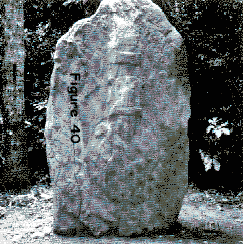
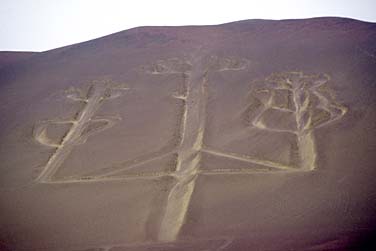
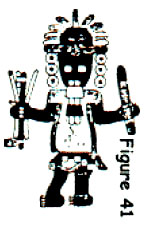
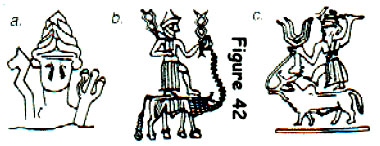
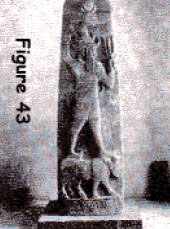
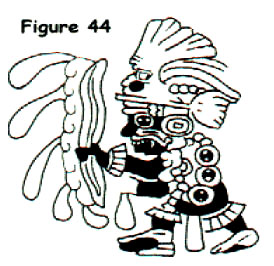
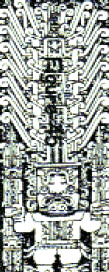
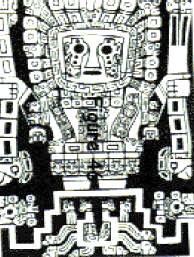

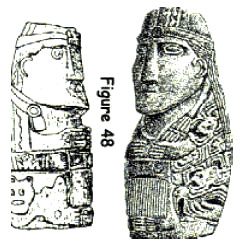
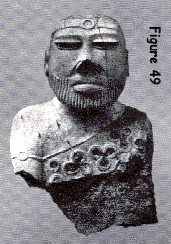
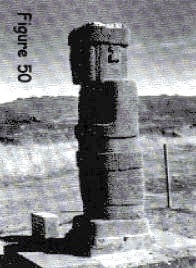
 is indeed a pictorial record of a technology
that was once used in the Americas, possibly for mining and stone
quarrying operations.
is indeed a pictorial record of a technology
that was once used in the Americas, possibly for mining and stone
quarrying operations. 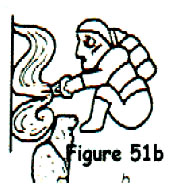 have been used by them, but were
certainly known to them. At their main city of Tula, they carved
13-feet high statues (known as the Atlantes) which held
modern-looking tools (Figure 51a). A Toltec relief carving on a
stone column at Tula shows exactly how these tools were used on the
rock face (Figure 51b). Similar tools, known as ThermoJets, have
been used in modern times to cut the giant monument at Stone
Mountain in Georgia, USA.
have been used by them, but were
certainly known to them. At their main city of Tula, they carved
13-feet high statues (known as the Atlantes) which held
modern-looking tools (Figure 51a). A Toltec relief carving on a
stone column at Tula shows exactly how these tools were used on the
rock face (Figure 51b). Similar tools, known as ThermoJets, have
been used in modern times to cut the giant monument at Stone
Mountain in Georgia, USA.  however, by
the nickname BURU, the pictograph for which resembles a mine-shaft
and bestows the meaning, according to Zecharia Sitchin, of “God of
the Deep Mines”.
however, by
the nickname BURU, the pictograph for which resembles a mine-shaft
and bestows the meaning, according to Zecharia Sitchin, of “God of
the Deep Mines”. 